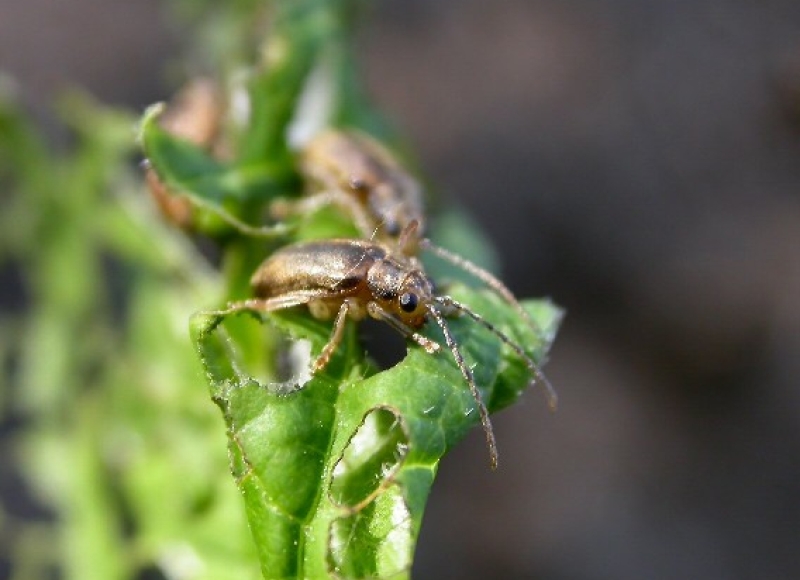Viburnum leaf beetle, Pyrrhalta viburni (Paykull), is a chrysomelid beetle, aptly named, as it feeds on leaves of viburnum. The damage potential from the beetle is quite extensive, if not managed. The beetle, first introduced from Europe to Ontario, Canada in 1947, has spread and is reported from Connecticut, Maine (1994), Massachusetts, New Hampshire, New Jersey, New York (1996), Pennsylvania, Ohio (2002), Pennsylvania,and Vermont. The beetle has been found in a number of sites in King, Skagit, Snohomish, Whatcom Counties in Washington State. It had previously been found in British Columbia.
Biology and Life cycle: Viburnum leaf beetle overwinters in the egg stage. Eggs are inserted into pits chewed into the stems, generally in a straight line. Larvae hatch from the eggs in the spring mid-late April. There are three larval stages (instars). Larvae eventually drop or crawl down the trunk of the plant to pupate in the soil. Pupae remain in the soil for about 10 days. Adults are found in the summer in July. Both larvae and adults feed on leaves. Adult females begin laying eggs in the late summer and fall. She can lay up to 500 eggs during her lifetime. There is only one generation per year.
Monitoring and damage: Look for oviposition scars on current year's growth. Look for holes in leaves in the spring by the larvae. They usually feed on the leaf undersides. Like many leaf beetle larvae, they superficially resemble a caterpillar but lack crochets (hooked appendages) on the prolegs. The newly hatched larvae are very small, around 1/8" long and are light yellow to tan. Their feeding damage tends to be leaf skeletonization. Larger larvae are light to dark green with black spots.The adult beetles are bronze-brown color and similar in size to an elm leaf beetle. Feeding by the adults tend to show up as larger holes in the leaves. Dieback from oviposition can also lead to terminal dieback on stems.
The following websites have useful information and images of viburnum leaf beetle:
Resources:
Viburnum: Viburnum Leaf Beetle. Hort Sense, WSU Extension.
Poor plant defenses promote invasive beetle's success, not lack of predators Cornell Chronical Online. April 11, 2011
Murray, T., E. LaGasa, C. Loony, and N. Afflito. 2016. Pest Watch The Viburnum Leaf Beetle. Washington State University Extension. <13 April 2016> New
Cornell's Viburnum Leaf Beetle: Citizen Science This site has some very nice information including a list of the Susceptibility to infestation
Original publication: 5/19/2004
Most recent update. 4/13/2016
Author: R.L. Rosetta, Extension Nursery Integrated Pest Management, Department of Horticulture, Oregon State University







